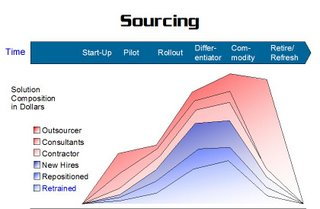ATD Blog
Building an Internal Simulation Capacity
Mon May 15 2006

Organization that want to build an internal simulation deployment capability should first learn from the best practices of other departments developing new competencies:
Developing New Organizational Competencies, 101
New projects often require skills that do not exist within a business unit, creating a gap that needs to be filled across the project's life. To produce the right portfolio of skills over the life of the project, managers have to juggle between:
outsourcers,
consultants,
contractors,
new hires,
repositioned employees, and
retrained employees.
Some organizations have outsourced everything, a strategy that gave them the immediate ability to compete, but ultimately was too expensive and rigid. Other companies have tried to develop the capacity from within, only to find that it took too long and the window off opportunity passed.
Many leading organizations have taken a hybrid path. They have begun with bringing in outside experts in different capacities and jumped start the process. While the project was being designed, they also began a parallel track of building an internal capacity, through training and hiring and shadowing. At some inflection point, the responsibility is shifted from external to internal.
Now, Simulations
With that as a bit of background, here are the skills an organization will need to develop, in order.
acquisition
- The best simulations will be bought "off-the-shelf" and mildly, if at all, customized.
In some academic environments, commercial off the shelf (COTS) computer games will better meet a need than any educational simulation. Evaluation criteria include: learning objectives, cost, ease of deployment.
measuring/evaluating situations
- Measuring the effectivness of sims is critical to growing and perpetuating any program.
project management
- Deploying and scheduling sims is a bit of work, although should be less impactful than scheduling a physical class.
coach/facilitator
- Coaches add pedagogy and motivation.
planning, strategic
- Where to use sims is a critical , but it is an issue that can only be fully understood after a few real simulation deployments.
- Build versus buy is a critical long term issue, although most organizations will want to leverage vendor experience initially.
web, creating
- An organiation should have people with a basic knowledge of HTML/CSS
Director and Flash, using
- Flash remains the first programming skill to need.
dedicated tool, branching story
- Moodle
dedicated tool, game based model
dedicated tool, interactive spreadsheet
dedicated tool, virtual lab
- But most people use the more general Director and Flash.
database, programming
- Data management/manipulation, from database (e.g. mySQL) to even manipulation of batches of number in Excel
languages programming
- Organizations need people with some sort of programming and scripting to generate interactivity. anywhere from JavaScript to ActionScript/Lingo to PHP/ASP
images, manipulating
- PhotoShop/PaintShopPro
sound, editing
- Audacity
developer, simulation/game
